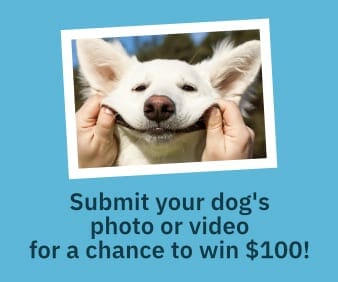What Is Entropion in Dogs?
Entropion in dogs is a condition that causes the lower eyelid to roll inward. When the eyelid rubs against the eye, the hairs on its surface can cause pain and discomfort to the dog. If left untreated, this condition can lead to perforations, ulcers, and the development of pigment on the dog’s cornea that could impact vision.
Although more common in the lower eyelid, the condition can also affect the dog’s upper eyelid and may also affect both eyes. If entropion is suspected in a dog, it is important to have a full ophthalmic assessment carried out by a veterinarian. The condition is the opposite of ectropion, which is where the dog’s eyelids will roll outward.
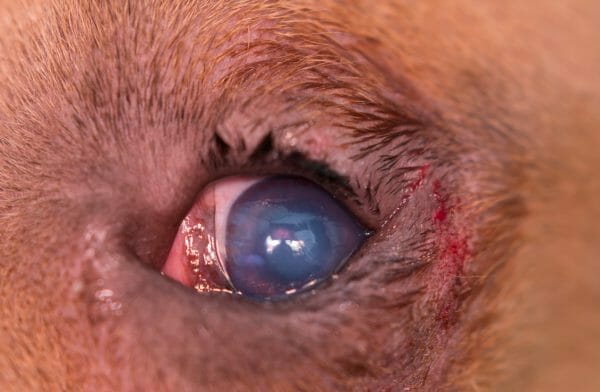
Entropion in Dogs Symptoms
In most cases, a dog with entropion will hold its eye shut, squint, and have excessive tears. Other signs of entropion in dogs include:
- Mucoid discharge in and around the eye
- Swelling surrounding the eyes
- Excessive blinking
- Eye twitching (blepharospasms)
- Sensitivity to light
- Conjunctivitis
- Redness in the eyes
- Corneal ulcer
- Corneal abrasions
- Lethargy
- Ulcers

What Causes Entropion in Dogs?
Although it is possible for any dog to develop entropion, genetics often play a big part. Usually, where the condition is brought about due to genetics, the condition will become evident within the first year of the dog’s life.
The condition is most likely to affect dogs that have lots of facial folds and wrinkles surrounding the eyes. Other factors associated with the condition include:
- Shape of the eyeball in relation to the eyelid
- Size and shape of the dog’s skull
- Length of the eyelid
- Shape of the bone cavity surrounding the eyeball
- Gender of the dog
Dog breeds that are predisposed to entropion are listed below:
- Akita
- American Staffordshire Terrier
- Basset Hound
- Bernese Mountain Dog
- Bloodhound
- Bulldog
- Chesapeake Bay Retriever
- Dalmatian
- Golden Retriever
- Great Dane
- Great Pyrenees
- Irish Setter
- Japanese Chin
- Labrador Retriever
- Mastiff
- Newfoundland
- Old English Sheepdog
- Pekingese
- Pomeranian
- Pug
- Rottweiler
- Shar Pei
- Saint Bernard
- Siberian Husky
- Spaniels (Clumber Spaniel, English Springer Spaniel, English and American Cocker Spaniel, Tibetan Spaniel)
- Staffordshire Bull Terrier
- Toy and Miniature Poodle
- Vizsla
- Weimaraner
- Yorkshire Terrier
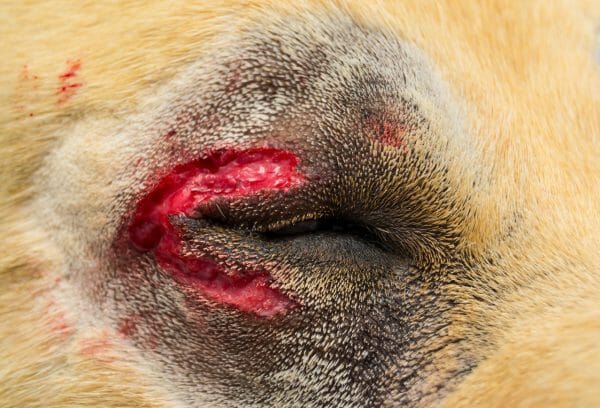
In some cases, the condition may be secondary to another condition, such as:
- Trauma
- Scarring of the eyelid
- Nerve damage
- Pain
- Infection
- Corneal spasms
- A lack of skin laxity in older dogs
- Obesity
In other cases, entropion may occur following the loss of neurological function over the eyelid.
Diagnosing Entropion in Dogs
If entropion is suspected in a dog, it should be taken to a veterinarian for a full assessment. The veterinarian will conduct a full ophthalmologic examination of the dog’s eyes and eyelids. During the examination, the dog will be awake and will not be sedated. This will ensure that the veterinarian is able to observe the normal shape of the eye.
The veterinarian will also perform a fluorescein test. This will determine whether any ulceration has occurred to the eyes. The test will involve placing a drop of fluorescein dye in the eye. The dye will adhere to any corneal damage.
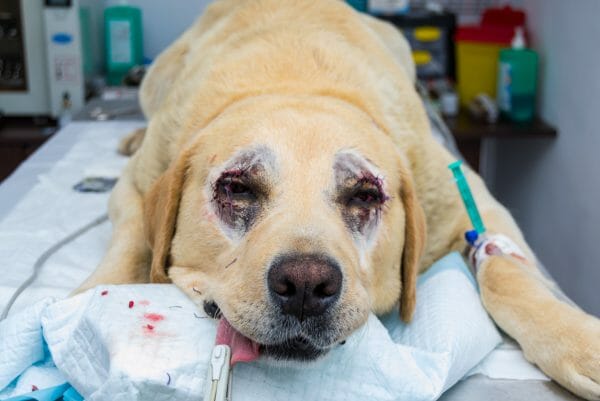
How to Treat Entropion in Dogs
Treatment for entropion in dogs will typically involve a surgical procedure. The surgery will remove any excess skin that surrounds the eyelids. By removing the extra skin, the eyelids will tighten and will return to their correct anatomical position.
If a puppy is under the age of 12 weeks, an eyelid tacking procedure may be carried out instead of the full surgical procedure.
When a puppy has its eyes tacked, there will be no removal of excess skin. Instead, the extra skin that surrounds the dog’s eye will be turned outward temporarily using tension sutures. By doing this, the puppy’s facial features will be allowed to fully develop and there will be no risk of the dog developing malformations in their eyelid.
There are some possible complications that may result after entropion surgery.
- Under correction. This happens when insufficient eyelid skin is removed, and the eyelid is still able to rub the cornea.
- Overcorrection. This occurs when too much skin is removed from the eyelid, preventing them from closing fully.
Complications following entropion eye surgery in dogs are rare. If a dog has entropion, surgical correction is always the best treatment option. Dogs that undergo entropion surgery have an excellent prognosis as the procedure will restore their vision and remove any pain and discomfort.
It most cases, the dog will also require eye drops before and after surgery. This will help manage symptoms such as inflammation and infection.
Eye drops for entropion might include the following:
- Lubricating eye drops to keep the eyes moist during the healing process
- Antibiotic eye drops to help manage any eye infection
- Anti-inflammatory eye drops to ease pain and inflammation
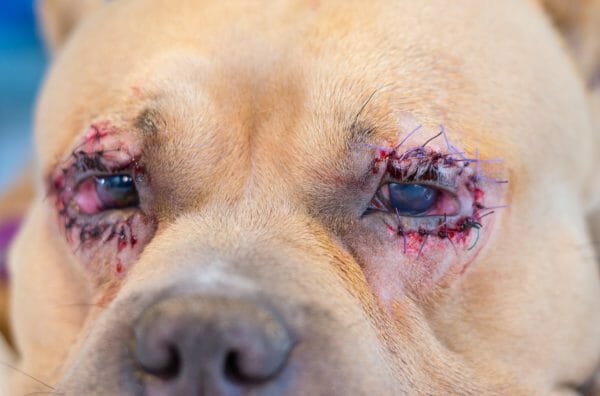
Entropion Surgery in Dogs Recovery
Most canines quickly recover after entropion surgery. The dog’s eyes will be swollen because of the surgery, which should start to subside around 24 hours after surgery. However, it may take 2 to 4 weeks to completely go down. During recovery, a dog will need to wear an E-collar (also known as an Elizabethan collar or “cone of shame”) to help protect the sutures in the eyelid.
If the dog has has any underlying corneal disease, the veterinarian may prescribe oral medications such as:
- Antibiotics
- Anti-inflammatories
- Analgesics
Two weeks after the surgery, the dog will need to return to the veterinarian so that the sutures can be removed. The E-collar will need to be worn for a few days following this because early removal may result in the dog injuring the site of the incision.
How to Prevent Entropion in Dogs
If a dog is predisposed to entropion, there is no way to prevent the condition from developing. Owners should monitor their dog’s eyes and be mindful of the conditions that cause entropion. Regular visits to the veterinarian will be important to help identify the condition early. Owners should also frequently clean the folds surrounding the eyes. In cases of genetic entropion, the affected dog should not be bred to prevent the gene from being passed on.


